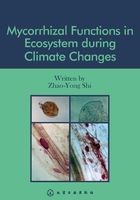
Chapter 1 Summarization of Mycorrhizal Functional Studies under Global Changes
1.Introduction
Mycorrhiza(mycorrhizae or mycorrhizas),the symbiotic association between a kind of soil fungi and the roots of a vascular plant,is generally considered as a mutualistic,but occasionally weakly pathogenic(Kirk et al.,2001).Actually,Smith and Read(2008)summarized that the term‘symbiotismus'(symbiosis)was probably first used by Frank(1877)as a neutral term that did not imply parasitism,but was based simply on the regular coexistence of dissimilar organisms,such as is observed in lichens.Mycorrhizal symbiosis benefit usually to host plants in majority environments.However,as will become clear,not all of those associations that are described as mycorrhizas have been shown to be mutualistic by experimental analysis of nutritional interactions or determination of fitness.Increasingly,it is recognized that,even in a single type of mycorrhiza,there may be a continuum of outcomes ranging from the mutualistic to the parasitic.Indeed,the relationship may change over the life of a single plant-fungus partnership(Smith and Read,2008).
However,the functions of all kinds of mycorrhizas have caused the attenetions of mycologists,ecologists,and biologists since mycorrhizas were reported.One of the reasons that mycorrhizas were paid much attention is its wide distribution in the ecosysterm.Trappe(1987)indicated that mycorrhizas exists in 95% of examined plant families while only a small proportion of all species has been investigated in the world.The symbiotic association is so widely that the international bank for the Glomeromycota(IBG,http://www.bio.ukc.ac.uk/beg/)said “The majority of plants,strictly speaking,do not have roots;they have mycorrhizas.The study of plants without their mycorrhizas is the study of artefacts”.
The mycorrhizas play important roles in regulating the functions of either plant individual or plant communities,even ecosystem.For example,it is well known that mycorrhizas improve the growth and acquisition of mineral nutrients even organic nutrients(Smith and Read,2008).In addition,mycorrhizas also influence the availability of soil nutritions.A lot of studies argue that some mycorrhizae distribute nutrients based upon the environment with surrounding plants and other mycorrhizae,in a manner similar to a capitalistic market.Researchers go on to explain how this updated model explains why mycorrhizae do not alleviate plant nitrogen limitation,and why plants can switch abruptly from a mixed strategy with both mycorrhizal and nonmycorrhizal roots to a purely mycorrhizal strategy as soil nitrogen availability declines(Franklin et al.,2014).
The mechanisms of increased absorption are both physical and chemical.Mycorrhizal mycelia are much smaller in diameter than the smallest root,and thus can explore a greater volume of soil,providing a larger surface area for absorption.Also,the cell membrane chemistry of fungi is different from that of plants(including organic acid excretion which aids in ion displacement).Mycorrhizas are especially beneficial for the plant partner in nutrient-poor soils.
2.Types of mycorrhiza
Mycorrhizas are commonly divided into ectomycorrhizas and endomycorrhizas.The two types are differentiated by the fact that the hyphae of ectomycorrhizal fungi do not penetrate individual cells within the root,while the hyphae of endomycorrhizal fungi penetrate the cell wall and invaginate the cell membrane(Harley and Smith 1983;Allen,1991;Smith and Read,2008).Endomycorrhiza includes arbuscular,ericoid,and orchid mycorrhiza,while arbutoid mycorrhizas can be classified as ectoendomycorrhizas.Monotropoid mycorrhizas form a special category.That is to say,generally speaking,there are seven different mycorrhizal types in natural ecosystems with the different characteristics(Table 1-1).
Table 1-1 The types of seven mycorrhizal types and their characteristics

Modified from Smith and Read(2008).
3.The researches of mycorrhiza and global changes
Mycorrhizas,as the symbiosis with plant roots,join in all kinds of ecosystem process(Figure 1-1).Therefore,the current researches focused on the following aspects:

Figure 1-1 Simplified overview of mycorrhiza in joining in ecosystem process including soil carbon balance,mineral nutrient uptake,etc.
(1)Mycorrhizal implications in CO2 fluxes of ecosystem including ecosystem and soil respiration under climate changes;
(2)Mycorrhizal importance in responses of ecosystem productivity to climate changes;
(3)Mycorrhizal implication in the responses of plant characteristics to climate changes.
4.The papers published on mycorrhiza and global changes
We searched the papers from different data(SCI,EI,Wangfang and CNKI data)published in three stages based on the subjects of “mycorrhiza(*)” and “climate change(*)”(Figure 1-2).The three stages were divided according to IPCC(The Intergovernmental Panel on Climate Chang)was created in 1988 and were awarded the Nobel Peace Prize in 2007.This result showed that the increased rate is higher in recent 7 years from 2008 to 2014 than former stages in SCI and 2 Chinese data.Certainly,the papers were mainly published in EI data before 2007.However,the SCI data have become the most important in reporting the subject with mycorrhiza and climate changes.In addition,the papers with the subject in Chinese increased rapidly in after 2007.From 2008 to 2014,the Chinese papers almost equal to these in SCI data.

Figure 1-2 The paper number with the subject “mycorrhiza(*)and climate change(*)” in different data in different periods
Further,the papers published with the subjects of “mycorrhiza(*)” and “climate change*” in each year were searched from 1985 to now in SCI data(Figure 1-3),which showed that they increased slowly before 2007,but went up sharply in 2007.Moreover,the increasing rate is higher after 2007 with the slope of 6.1667 than these in before 2007(0.1368).

Figure 1-3 The paper number with the subject “mycorrhiza(*)and climate change(*)” in SCI data in different years